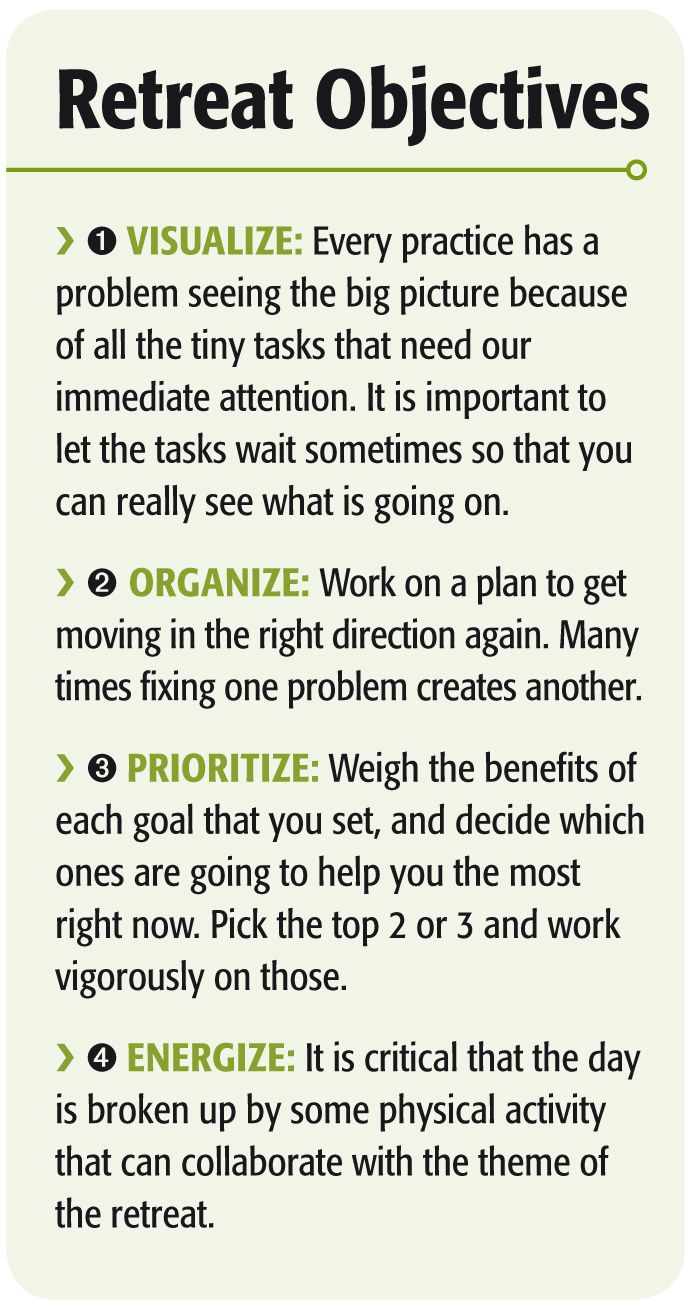Benefits of a staff retreat
Since I began my practice, I have made a habit of regular office retreats. Even in the early days, with a staff of 1, we found time to get away and talk about what we were trying to accomplish with the practice. And later, with 3 doctors and very full schedules, we continued to make it happen.

Since I began my practice, I have made a habit of regular office retreats. Even in the early days, with a staff of 1, we found time to get away and talk about what we were trying to accomplish with the practice. And later, with 3 doctors and very full schedules, we continued to make it happen.
When I tell a doctor about the huge benefits of retreats I am often told, “It doesn’t make sense for me to have a retreat because we are so small; we can talk anytime.” Or I hear, “That sounds great, but we just don’t have the time since we are so busy.” I get it, and neither is a good reason to not do it.
There are few things that I think are good for everybody, but getting away to visualize, organize, prioritize, and energize is always good. A retreat is good for any organization, big or small, and many high-level executives realize these benefits and are moving toward incorporating these lessons.
There are no hard and fast rules about topics that need to be covered at an office retreat. You do need a theme, however. It can be as broad as a dream session to create an elaborate vision of who we really want to be, or it can be as specific as learning about the new EHR program. But the 4 objectives should always be met.
Retreat Objectives
1. Visualize. You’ve heard it said, “You can’t see the forest for the trees.” Well we can’t see our practice for the patients. Or the lab orders, or the insurance claims, or staff members, or bills. Every practice I have ever been to has a problem seeing the big picture because of all the tiny tasks that need our immediate attention. It is important to let the tasks wait sometimes so that you can really see what is going on.
2. Organize. After you take a step back to explore every aspect of the practice and begin to get a picture of the true state of the practice, you can work on a plan to get moving in the right direction again. Many times fixing one problem creates another. By getting contributions from the entire team, the plan starts to click with everyone.
3. Prioritize. If you try to do everything at the same time, you will do a bad job at all of it. Trust me; I have done it over and over. It is essential that you weigh the benefits of each goal that you set and decide which ones are going to help you the most right now. Pick the top 2 or 3 and work vigorously on those. Many of the rest will just happen, and the others will be OK undone.
4. Energize. Retreats without some fun built in are just meetings. Nobody loves a meeting more than me, but I can take only so much. It is critical that the day is broken up by some physical activity that can collaborate with the theme of the retreat. Ropes courses are great for team building, and bowling is good for laughing together. (Chill out for a minute, doc.)
Tips for a successful retreat
The doctor/retreat leader should not do most of the talking. She should ask a lot of questions and work hard to get truthful answers. It takes time and practice, so you might as well get started now.
The topics we cover at a retreat can vary widely. If we are in a position in which we need to redefine ourselves or bring a new energy into the practice, we focus the retreat on brainstorming new ideas and broadening our horizons. With this technique, we want to define 2 or 3 big goals that we want to accomplish in the upcoming year.
If we are in a position in which we just need to get our acts together, we may perform a SWOT analysis. SWOT stands for strengths, weaknesses, opportunities, and threats. We list them all and decide what we need to do about it. The purpose of this is to identify a few tasks to get us through the barriers we are currently facing.
Sometimes there is a big, overwhelming topic that dominates the retreat. For instance, when we switched EHR programs, we focused an entire retreat to how we need to adapt to the new program.
Retreats can be done in the office, but that is not ideal. It is best to get out of the office and away from the normal work environment. There are no rules about where to meet, but the location does become a main character of the retreat. Be creative with the location.
The costs can vary widely. We have used the local library for free and have met at a local resort and spent over $1,000-it is always a valuable investment.ODT
Newsletter
Want more insights like this? Subscribe to Optometry Times and get clinical pearls and practice tips delivered straight to your inbox.